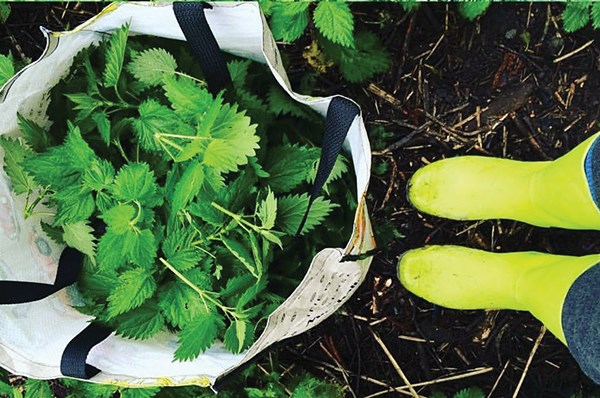���pring is nature’s way of saying, ‘Let’s party!’”Robin Williams once said. In these parts, spring is nothing short of epic. There’s so much beauty and life, shades of green, new buds and blossoms. The forests are basically offering themselves up in the way of foods and medicines.
I’m the first to admit, I am a foraging fan. It’s like treasure hunting. I grew up picking fiddleheads, wild ginger and canning wild leeks. And being from Quebec, of course we boiled off lots of maple syrup.
To me, there are few things more exciting than finding a motherload of nettles to steam, ferment or infuse to help with allergies, bump up your iron stores or as a delicious spring tonic. Or a field full of dandelions for salad, medicine or dandelion wine. Some people curse these little flowers and their effect on their pristine lawns calling in Captain Round Up to beautify their personal patch of green. I say, bring them on! Better food and nutrients than chemicals and a questionably useful area of grass.
I recently had the pleasure of talking to two foraging gurus with deep knowledge of the �ϰ������ϲʿ�����¼���� offerings: Camille Flanjak from Museum Eats and Isabelle Ranger from Namasthe Teas. Both women, I feel, are making the world a better place.
Flanjak and I chatted about all of the wild greens that are in abundance right now – fireweed shoots, for example. All of the berry shoots available are edible and are delicious dipped in hummus, like thimble berry and salmonberry, which is her favourite. Birch tree leaves are also delicious and are much like rapini when mixed in a salad. It turns out birch is very useful and edible – not only the leaves, but the part between the bark and the tree itself can be ground up and made into flour. And of course our version of Quebec’s maple syrup is birch syrup made from the sap.
There are also other wild greens like purslane, plantain and miner’s lettuce. Oregon grape shoots are scrumptious. Wild mustards, rapeseeds, wild turnips and radishes are all out and on offer. Flanjak says that you can tell it’s a brassica if there are four petals on the flower. Of course there are also spruce and fir tips that can be used for teas or other edibles as well. Cat tail shoots are another sweet salad ingredient and the reed is used for weaving. Cat tails are being experimented with in the Kootenays for ethanol and also feed to cows to create a lower methane byproduct. Cool, huh? If foraging for cat tails, please avoid the estuary as that area is protected. That said, it is important to respect and honour wherever you pick.
Foraging can be intimidating, and rightly so. Some plants are poisonous, so it is important to be sure about what you are picking and how to process them. For instance, according to Flanjak, the Gosari bracken fern that grows abundantly in these parts is a widely foraged edible among Korean people, but it must be blanched three times in boiling salted water and then dried. Like raw chicken, it needs to be prepared properly. The bracken fern contains cyanide, as do the pits, used to make amaretto. Cyanide is poisonous, of course, but the bracken fern is also used medicinally by some to treat against cancer.
Flanjak teaches classes (listed at museumeats.com/events). She also oganizes group foraging days. There are wonderful books out there for self-guided explorations such as Edible and Medicinal Plants of the Rockies by Linda Kershaw and Plants of the Pacific Northwest by Nancy Turner.
For my next column, I will share some tips from Ranger. ‘Til then, happy foraging!




